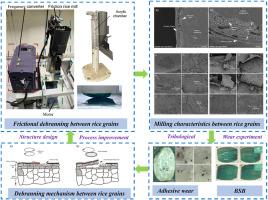Investigation of rice debranning mechanism based on tribological behaviour between rice grains
IF 4.4
1区 农林科学
Q1 AGRICULTURAL ENGINEERING
引用次数: 0
Abstract
Frictional debranning between rice grains is a fragile and energy-consuming process. Understanding the mechanism of this frictional debranning is the key to achieving moderate debranning, yet the mechanisms involved remain poorly understood. In this work, the mechanism of rice grain debranning was investigated through rice milling experiments, SEM analysis of the rice surface, and rice wear experiments. The results showed that the bran layer of rice grains exhibited different removal patterns at different milling pressures. During frictional debranning between rice grains, adhesive wear and bulk stripping of the bran layer occurred. The bran layer of the rice grain initially experiences primary damage due to adhesive wear, followed by bulk stripping at the edges of the existing damage. Pre-milling can effectively improve the debranning efficiency of rice grains. These findings should provide a theoretical reference for the design of grain milling equipment and the process improvement of grain moderate milling.

基于米粒间摩擦学行为的水稻脱粒机理研究
米粒之间的摩擦脱粒是一个脆弱且耗能的过程。了解这种摩擦脱粒的机理是实现适度脱粒的关键,但人们对其中的机理仍然知之甚少。在这项工作中,通过碾米实验、大米表面的 SEM 分析和大米磨损实验研究了米粒脱粒的机理。结果表明,在不同的碾米压力下,米粒糠层表现出不同的脱粒模式。在米粒间的摩擦脱粒过程中,米糠层发生了粘着磨损和松散剥离。米粒的糠层最初因粘着磨损而出现初级损伤,随后在现有损伤的边缘出现大量剥离。预碾磨能有效提高米粒的脱粒效率。这些研究结果可为谷物碾磨设备的设计和谷物适度碾磨工艺的改进提供理论参考。
本文章由计算机程序翻译,如有差异,请以英文原文为准。
求助全文
约1分钟内获得全文
求助全文
来源期刊

Biosystems Engineering
农林科学-农业工程
CiteScore
10.60
自引率
7.80%
发文量
239
审稿时长
53 days
期刊介绍:
Biosystems Engineering publishes research in engineering and the physical sciences that represent advances in understanding or modelling of the performance of biological systems for sustainable developments in land use and the environment, agriculture and amenity, bioproduction processes and the food chain. The subject matter of the journal reflects the wide range and interdisciplinary nature of research in engineering for biological systems.
 求助内容:
求助内容: 应助结果提醒方式:
应助结果提醒方式:


